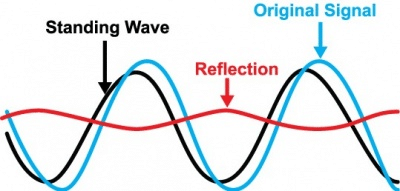In order to deliver the maximum amount of power from a power amplifier to an antenna, the impedances must be matched. The parameter used to measure how well the impedances are matched is the Voltage Standing Wave Ratio (VSWR). VSWR is a reflection coefficient known as ‘return loss’. It is a measure of how much energy is reflected back into the system.
If the VSWR is too high, there could potentially be too much energy reflected back into a power amplifier, causing damage to the internal circuitry. In an ideal system, there would be a VSWR of 1:1. Causes of a high VSWR rating could be use of an improper load or something unknown such as a damaged transmission line. But how exactly does this effect the signal or cause damage to the PA?
The mismatch loss formula: MLdB=-10log10(1-(VSWR-1/VSWR+1) 2) can be used to determine the mismatch loss in dB as a function of VSWR. In a system with a 2:1 VSWR, there will be a loss of approximately .5 dB. A 10:1 VSWR will cause close to 5 dB of loss in signal strength. As the VSWR increases, the reflected power back into the system increases. Most components can not absorb all of this energy and can cause the device to malfunction or become permanently damaged.
At NuWaves RF Solutions, all of the power amplifiers are tested to ensure the internal components can withstand a number of VSWR mismatches. The various power amplifiers offered by NuWaves are rated for up to 10:1 VSWR. However, the tests are also performed with an open and short and are capable of withstanding a theoretical infinite VSWR rating. Although this is not recommended, the products offered at NuWaves are built to withstand the rigors of field use.

Figure 1: Voltage Standing Wave Ratio (VSWR) [Courtesy of All About Circuits]
To view our line of miniature and high-efficiency amplifier modules, click here. To view our full spectrum of solutions, check out our RF design and Engineering Solutions we have to offer as well as our full product lineup.

